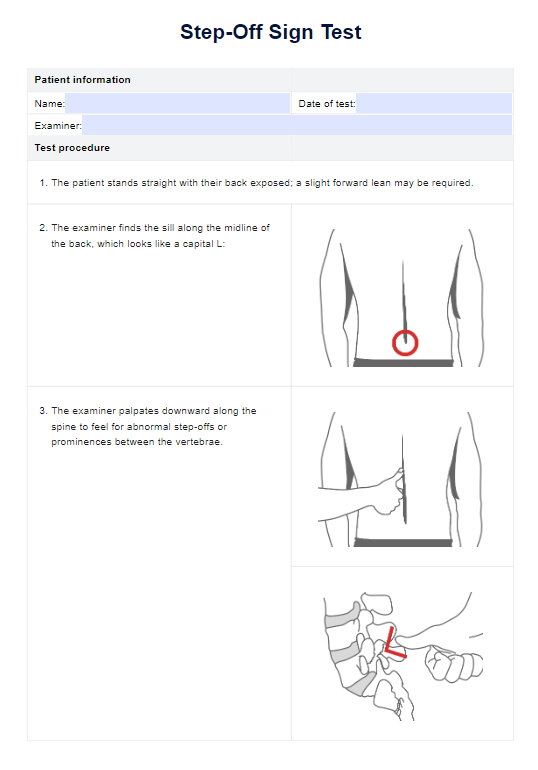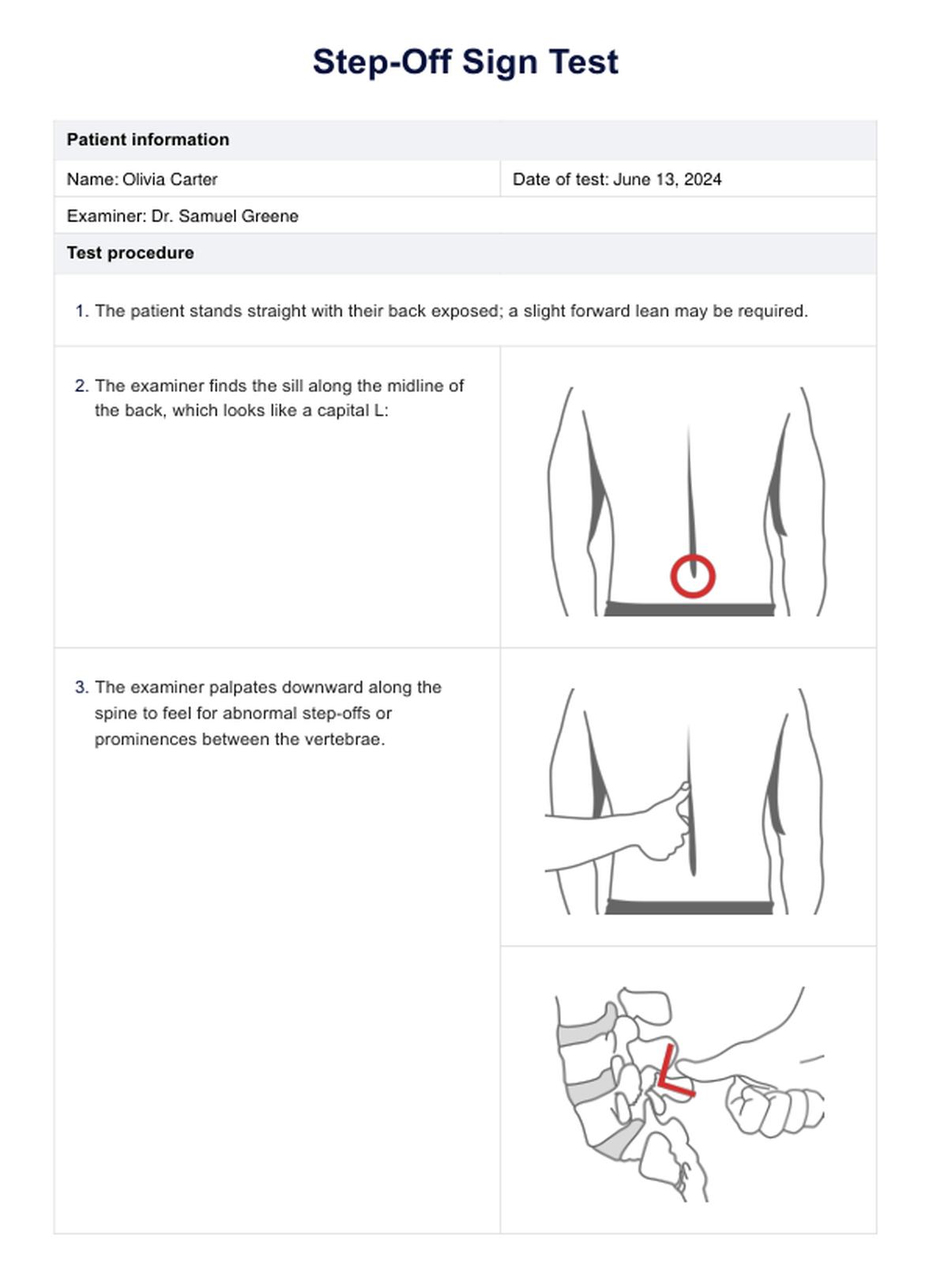Step-Off Sign Test
Learn how the Step Off Sign Test is crucial for diagnosing lumbar spondylolisthesis. Access our free PDF to understand test procedures, interpretation, and more.


What is spondylolisthesis?
Spondylolisthesis is a spinal condition where one vertebra slips forward over the one below it, often affecting the lumbar region. This displacement can lead to significant discomfort and limit mobility, impacting an individual's daily life. There are several types of lumbar spondylolisthesis, classified based on their origin:
- Congenital spondylolisthesis (dysplastic spondylolisthesis): This type occurs from birth and results from abnormal bone formation in the spine, leading to vertebral slippage at a young age.
- Isthmic spondylolisthesis: This form, often seen in children and adolescents, arises due to a defect or stress fracture in the pars interarticularis, a small segment of the vertebral arch. This can be further classified into three subtypes: A (Pars interarticularis fatigue fracture), B (Pars interarticularis elongation due to multiple healed stress effects), and C (acute Pars fracture)
- Degenerative lumbar spondylolisthesis: This is the most common form, typically affecting adults over 50. It results from the deterioration of spinal discs and joints, such as disk degeneration and facet joint degeneration, without an associated disruption or defect in the vertebral ring.
- Traumatic spondylolisthesis: This type is caused by direct trauma or injury to the vertebrae. It involves a fracture in parts of the vertebra other than the pars interarticularis.
- Pathologic spondylolisthesis: This type occurs when the spine is weakened by a disease, such as a tumor or infection. This compromises the integrity of the vertebrae and leads to slippage.
Understanding the specific type of spondylolisthesis is crucial for effective treatment. Accurate diagnosis is essential to tailor these strategies effectively, ensuring that each patient receives the appropriate care based on the nature and severity of their condition.
Symptoms of spondylolisthesis
The primary symptoms of spondylolisthesis are lower back pain (which can radiate to the buttocks and thighs), stiffness, and sciatica. One key factor influencing these symptoms is pelvic incidence (PI). PI measures the angle between a line perpendicular to the sacral endplate at its midpoint and a line connecting this point to the axis of the femoral head. Increased PI can influence the degree of lumbar lordosis and sacral slope, potentially worsening spondylolisthesis symptoms.
Symptomatic patients may also experience the following:
- Muscle tightness or stiffness in the back and legs.
- Nerve compression leads to tingling, numbness, or weakness in the legs.
- Increased pain when bending backwards or twisting.
- Loss of bladder or bowel control in severe cases, indicating possible cauda equina syndrome.
Causes
Accidents or injuries cause immediate damage to the vertebrae, while overuse can also contribute to degeneration. This is why it is also common in athletes involved in sports that stress the lower back. In addition, degenerative issues like arthritis can lead to instability and slippage. Lastly, family history can increase the likelihood of congenital defects.
Differences between spondylolysis and spondylolisthesis
Spondylolysis refers to a crack or stress fracture in one of the vertebrae, typically without leading to any vertebral displacement. This condition often results from repetitive stress or overuse, particularly in activities that involve twisting or hyperextension of the spine.
In contrast, spondylolisthesis occurs when a vertebra slips, which may sometimes be a progression from spondylolysis if the affected vertebra shifts. This displacement can compress spinal nerves and lead to symptoms such as pain, numbness, and muscle weakness. The condition can be worsened by factors such as degenerative changes in the lumbar spine, particularly in the facet joints and discs, which can reduce spinal stability and lead to vertebral slippage.
Both conditions are treatable, with management strategies including physical therapy treatment to realign and stabilize the vertebrae.
Step-Off Sign Test Template
Step-Off Sign Test Example
What is the Step-Off Sign Test?
The Step-Off Sign Test, also known as the low midline sill sign test or slipping palpation, is essential for detecting degenerative spondylolisthesis, particularly in the lumbar spine. This procedure involves a clinician palpating the lower back to find any noticeable 'step-off' (or lumbar lordosis) at the vertebrae. On this classic sign, one vertebra has shifted forward over another, often due to degeneration of the lumbar discs and facet joints.
This method is particularly beneficial as a screening tool. Nevertheless, imaging is the gold standard in diagnosing spondylolisthesis, since the grade of slippage can only be determined through imaging. Imaging can also be used to determine if complications or similar issues like spinal stenosis are present. Moreover, other physical tests are recommended if you want to form a comprehensive assessment of lumbar instability.
How is this test conducted?
The Step Off Sign Test is a simple physical examination performed by clinicians to detect spondylolisthesis in the lumbar spine. The process includes the following steps:
- The patient stands straight with their back exposed. The clinician may ask the patient to lean slightly from the waist to palpate the lumbar spine better.
- The clinician uses their fingers to palpate along the spine, feeling for abnormal step-offs or prominences between the vertebrae. This involves pressing on the lower back where the lumbar vertebrae are located.
This test is particularly important in cases where patients exhibit symptoms such as chronic low back pain, neurogenic claudication, or signs of cauda equina syndrome, which can all be associated with degenerative changes in the lumbar spine.
How are the results interpreted?
The interpretation of the Step Off Sign Test is crucial for diagnosing the extent of spondylolisthesis and planning appropriate treatment:
- Negative result: If no step-off is palpable, it is likely that the patient does not have a significant spondylolisthesis. However, the absence of a step-off does not completely rule out other lumbar spine issues.
- Positive result: A positive sign is indicated when there is a noticeable step-off or a palpable L-shaped dip between the vertebrae, suggesting one vertebra may be slipping forward relative to the one below it. The severity of the step-off can give a preliminary idea of the slippage grade.
If a step-off is detected, additional diagnostic tests such as X-rays, magnetic resonance imaging (MRI), or CT scans are recommended to confirm the diagnosis and assess the degree of vertebral displacement.
How to use our Step Off Sign Test template
Download our printable Step Off Sign Test template to implement this diagnostic tool in your clinical practice effectively. To ensure comprehensive documentation, begin by entering the patient's details, such as name, date, and specific symptoms. Proceed with conducting the Step Off Sign Test, using the sections of the template to record findings like palpable step-off and patient responses.
Download our free Step Off Sign Test template example here

Common treatments for spondylolisthesis patients
Treatment strategies for spondylolisthesis are tailored based on the severity of the condition and the patient's specific needs. Here's an in-depth look at the common approaches:
Conservative treatment
This is the first line of treatment, especially for patients with mild symptoms. Physical therapy is crucial; it focuses on strengthening the core and lumbar muscles to stabilize the spine and alleviate stress on the affected vertebrae. Pain management often includes non-steroidal anti-inflammatory drugs (NSAIDs) or, in some cases, epidural steroid injections to reduce inflammation and pain. Patients are also advised to modify their daily activities to avoid motions that exacerbate the condition, such as heavy lifting or excessive bending and twisting.
Surgical intervention
Surgical treatment is considered when conservative measures fail to relieve symptoms or if the patient experiences significant functional impairment, severe pain, or neurological symptoms such as cauda equina syndrome. The most common spinal surgery procedure is spinal fusion. A specific type, called posterolateral fusion, involves joining two or more vertebrae permanently via bone graft to eliminate movement between them, thereby providing stability and reducing pain. For patients with less severe slippage or those for whom preservation of motion is possible, they may opt for minimally invasive surgeries like repair of the defective vertebra or decompression of the spinal canal.
Commonly asked questions
A positive Step Off Sign indicates the presence of spondylolisthesis, where there is palpable vertebral slippage along the spine. This sign is crucial for diagnosing the condition, particularly when a vertebra has moved enough to be felt through manual examination.
The treating healthcare provider should determine the frequency of the Step Off Sign Test based on the patient’s symptoms and the stability of their condition. It might be conducted periodically to monitor any progression of the slippage or in response to changes in symptoms.
The Step Off Sign Test alone cannot differentiate between the types of spondylolisthesis, such as congenital, isthmic, or degenerative. It is primarily used to detect the presence of slippage. Further diagnostic tools and imaging studies are required to determine spondylolisthesis's specific type and cause and to accurately measure the grade of slippage.

.jpg)





































































































